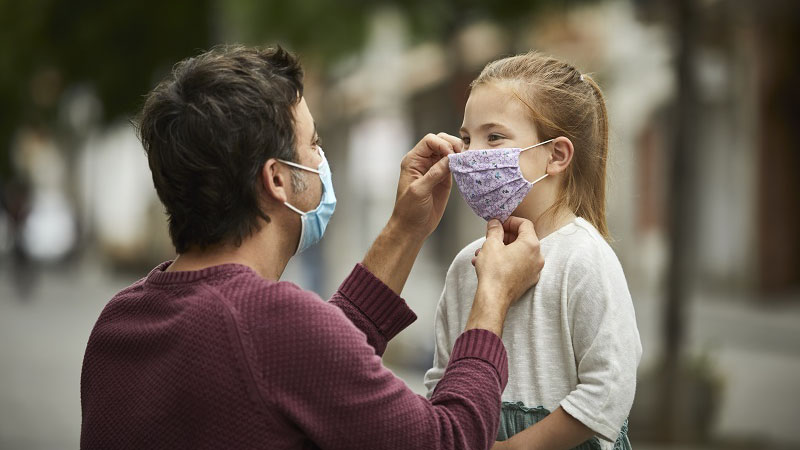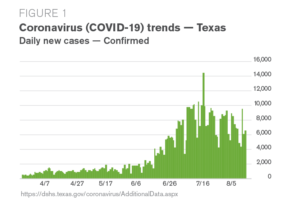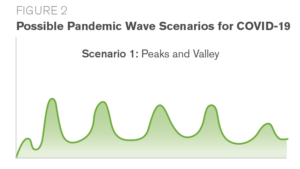
My Fellow Americans,
Another holiday weekend will be here before we know it. Labor Day is traditionally a time to gather one last time to celebrate the end of summer. That’s what we normally do, but this has not been a typical year. And if we’re not careful, we could be in for a historic fall.
I know you’re hearing a lot of warnings and frightening predictions about another possible spike in COVID-19 cases. Those warnings are based in fact and very recent events. Take this past Fourth of July weekend. Despite warnings from health and public leaders, many ignored social distancing guidelines and pleas to wear a mask.
This chart (Figure 1) shows the impact in Texas alone. On July 3 – the Friday kicking off the holiday weekend – there were 7,555 daily new cases of COVID-19 in Texas. Fourteen days later, the number of confirmed cases almost doubled to 14,916.

Texas was not alone. California experienced double-digit increases in 37 of that state’s 58 counties. ¹ Suddenly, people were talking about “superspreaders,” defined as individuals who are more likely to infect others with highly contagious viruses. The Centers for Disease Control and Prevention (CDC) says these individuals can be responsible for up to 80% of all transmissions. Thanks to these summer revelers,
the nation spent weeks trying to flatten the COVID curve.
Now, here we go again. We are about to enter a holiday weekend defined as a time for relaxation and social gatherings. It’s a recipe for another major spike. It may also answer a question we asked at the start of this pandemic. How will this all unfold?
In May, I told you about a report from the Center for Infectious Disease Research and Policy (CIDRAP). ² It looked at the future of this pandemic and predicted one of three scenarios.
The first was the “Fall Peak,” described as a spike in the spring followed by a second wave in fall or winter.

The second was called the “Slow Burn,” characterized by a spike in the spring and followed by months of no identifiable pattern of infection.
The final was “Peaks and Valleys,” with an initial wave in the spring followed by a series of small waves of infections, lasting up to two years (Figure 2).
This summer has been characterized by a number of peaks and valleys, all brought upon by human behavior and our failure to adhere to some basic principles. Here’s how the CDC says we can protect ourselves.
- Wash your hands regularly with soap and water, or clean them with alcohol-based hand sanitizer.
- Maintain at least six feet of distance from others.
- Avoid touching your face.
- Cover your mouth and nose with a mask when around others.
- Cover coughs and sneezes.
- Clean and disinfect frequently touched surfaces.
- Monitor your health daily.
I’m not telling you not to relax or enjoy yourself. But I urge you to be smart about it. If you get together with others, keep your circle small. Make sure those around you have the same commitment to health and safety that you do. And even still, social distance and wear a mask.
Be safe. Be smart. Be mindful of others. And know that WellMed CARES about your continued health and wellbeing.
¹ “California COVID-19 cases spiked after July 4th. Family gatherings helped the spread, experts say.” Mark Olalde, Nicole Haydem, The Herald News, Aug. 3, 2020 https://www.heraldnews.com/news/20200803/california-covid-19-cases-spiked-after-july-4th-family-gatherings-helped-spread-experts-say
² “COVID-19: The CIDRAP Viewpoint,” Kristine A. Moore, MD, MPH, Marc Lipsitch, DPhil, John M. Barry, MA, Michael T. Osterholm, PhD, MPH, , April 30, 2020 https://www.cidrap.umn.edu/sites/default/files/public/downloads/cidrap-covid19-viewpoint-part1_0.pdf
